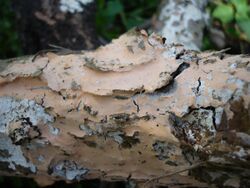Biology:Corticiales
| Corticiales | |
|---|---|

| |
| Erythricium laetum | |
| Scientific classification | |
| Domain: | Eukaryota |
| Kingdom: | Fungi |
| Division: | Basidiomycota |
| Class: | Agaricomycetes |
| Order: | Corticiales K.-H. Larsson (2007) |
| Families | |
|
Corticiaceae | |
| Synonyms[1] | |
|
1907 Protohymeniales Lotsy | |
The Corticiales are an order of fungi in the class Agaricomycetes. The order is composed of corticioid fungi. Species within the order are generally saprotrophic, most of them wood-rotters, but several are parasitic on grasses or lichens. Plant pathogens of economic importance include Erythricium salmonicolor, Laetisaria fuciformis, Waitea circinata, Waitea oryzae, and Waitea zeae.
Taxonomy
The order was established in 2007 by Swedish mycologist Karl-Henrik Larsson, based on molecular phylogenetic research.[2] It includes the Corticiaceae (the type family) as well as the Dendrominiaceae, Punctulariaceae, and Vuilleminiaceae.[3]
Habitat and distribution
The order is cosmopolitan and contains around 150 species of fungi worldwide.[4] The majority of species in the Corticiales are saprotrophs, most of them wood-rotters, typically found on dead attached branches. Some species of Laetisaria are facultative or obligate parasites of grasses; some species of Erythricium and Waitea are also facultative plant parasites; and some species of Erythricium. Laetisaria, and Marchandiomyces are parasites of lichens.[5]
Economic importance
Erythricium salmonicolor is an important plant pathogen causing "pink disease" of Citrus and other trees. Waitea oryzae and Waitea zeae are pathogens of commercial cereal crops, causing a number of diseases including sheath spot of rice.[6] Waitea circinata causes brown ring patch in turf grasses.[7] Laetisaria fuciformis is the cause of red thread disease in turf grass.[8]
References
- ↑ "Corticiales K.H. Larss. 2007". MycoBank. International Mycological Association. http://www.mycobank.org/MycoTaxo.aspx?Link=T&Rec=501299. Retrieved 2010-12-03.
- ↑ Hibbett DS (2007). "A higher level phylogenetic classification of the Fungi". Mycological Research 111 (5): 509–547. doi:10.1016/j.mycres.2007.03.004. PMID 17572334.
- ↑ Ghobad-Nejhad M; Nilsson RH; Hallenberg, Hallenberg, N (2010). "Phylogeny and taxonomy of the genus Vuilleminia (Basidiomycota) based on molecular and morphological evidence, with new insights into Corticiales". Taxon 59 (5): 1519–1534. doi:10.1002/tax.595016.
- ↑ Dictionary of the Fungi (10th ed.). Wallingford, UK: CABI. 2008. pp. 12–13. ISBN 978-0-85199-826-8. https://archive.org/details/dictionaryfungit00kirk.
- ↑ "Remarkable nutritional diversity of basidiomycetes in the Corticiales". American Journal of Botany 95 (7): 816–823. 2010. doi:10.3732/ajb.0800078. PMID 21632407.
- ↑ "Aggregate sheath spot and sheath spot of rice". Crop Protection 26 (6): 799–808. 2007. doi:10.1016/j.cropro.2006.06.016.
- ↑ "Brown Ring Patch: A new disease on bentgrass caused by Waitea circinata var. circinata". Plant Disease 89 (6): 536–542. 2005. doi:10.1094/PD-89-0536. PMID 30795375.
- ↑ "Red Thread lawn disease - cause, symptoms and treatment". http://www.lawnandmower.com/red-thread-disease.aspx. Retrieved 2010-12-03.
Wikidata ☰ Q2998105 entry
 |

